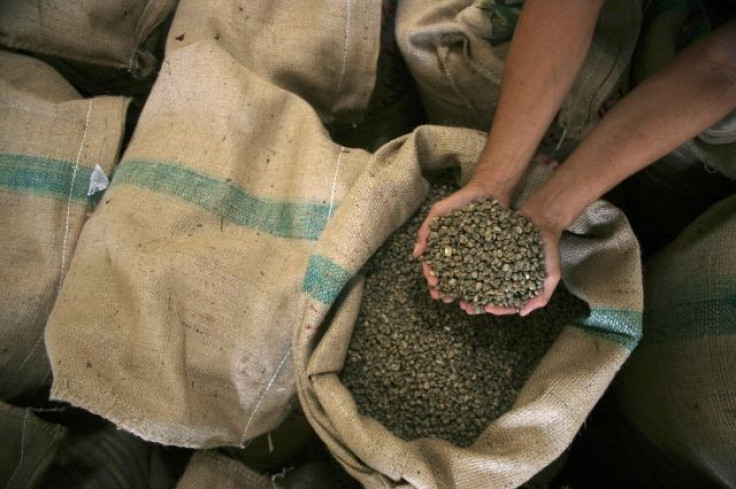Coffee-Processing Workers May Be At Risk For Flavorings-Related Lung Disease

Two workers at a small coffee-processing plant in Texas developed a rare, irreversible lung disease after breathing in flavoring chemicals. A new case study in the latest Morbidity and Mortality Weekly Report from the Center for Disease Control and Prevention (CDC) suggests that obliterative bronchiolitis may be underdiagnosed in the coffee-processing industry.
What is Obliterative Bronchiolitis?
The obstructive lung disease, also known as bronchiolitis obliterans or "flavorings-related lung disease," is associated with overexposure to airborne flavoring chemicals at work, according to the CDC. Inhaling too many of the chemicals inflames the bronchioles, the smallest airways in the lungs, causing scarring and constriction that blocks air flow.
Symptoms start with coughing, wheezing, and shortness of breath, which appear gradually and increase in severity over time. The best method of reducing lung damage is to remove patients from flavoring chemical exposure early— in severe cases, people may need lung transplants.
Obliterative bronchiolitis has previously been found among workers at a Missouri microwave popcorn factory, who developed "popcorn lung" after inhaling butter-flavoring chemical additives like diacetyl, as well as in a Colorado man who was awarded $7.2 million in damages after eating microwave popcorn every day for a decade.
A 2000 investigation led the United States Occupational Safety & Health Administration to promote standards that protect workers exposed to flavoring chemicals, though the recommendations are not specific to diacetyl or other butter flavorings.
A Case Study of Two Coffee-Processing Employees
Flavorings-related lung disease has not previously been identified among coffee-processing workers.
Both cases in the CDC report were previously healthy, nonsmoking individuals in their 30s who were misdiagnosed before doctors realized they had work-related obliterative bronchiolitis.
One of them, a 34-year-old woman who operated the grinding and packing machines for roasted coffee beans mixed with liquid flavorings from 2007 to 2009, developed respiratory symptoms after one year at the plant. She was treated for possible asthma as her breathing problems kept worsening, until high-resolution imaging and an open lung biopsy revealed severely damaged bronchial tissue. Today, she is waiting for a lung transplant.
The other patient was a 39-year-old man who started as a mixer in 2010, pouring liquid flavoring chemicals into barrels of roasted coffee beans. He started to notice shortness of breath with moderate activity after 18 months, and was given steroids for bronchitis. His breathing kept declining, and eventual lung imaging and open biopsy allowed doctors to diagnose him with obliterative bronchiolitis. As of May 2012 his condition was not as severe as the other case, though he still felt fatigue and worsening shortness of breath.
Are Baristas and Other Coffee Handlers at Risk?
Obliterative bronchiolitis is rare, even with occupational exposure to certain chemicals.
According to OSHA and the CDC, someone would have to inhale significant amounts of flavoring chemicals evaporated from their volatile liquid or solid form over a long period of time in order to be at risk.
Such exposure is unlikely for baristas and coffee aficionados who handle coffee beans with flavor additives, since the added chemicals are no longer in their most volatile form.
It's unclear, however, what these two cases mean for the risk of other workers who industrially process flavored coffee and handle flavoring chemicals.
Investigators were unable to quantify how much exposure the patients had to flavoring chemicals, or to identify why they developed the illness and no one else at the coffee-processing facility did. The CDC is currently collecting data on the other employees' exposure.
It's also unknown how much diacetyl specifically contributes to lung deterioration. While coffee-processing plants sometimes add extra diacetyl flavoring, the CDC report says that the chemical is a natural byproduct of many food processes, including coffee roasting, and may be released in small amounts when grinding beans.
Lastly, it's possible that some unique quality of the plant in Texas caused the illness, since production practices vary greatly among different coffee-processing facilities.
Flavoring Chemical Companies Face Consequences
In the meantime, the risk of flavoring chemicals in coffee-processing facilities has already spurred legal action.
In May 2012, workers at Distant Lands Coffee in Texas, likely the same processing plant in the CDC report, filed a lawsuit against their employers claiming that diacetyl exposure gave them the lung disease.
Later that summer, Starbucks ended business with an Indiana flavoring manufacturer that was fined by the National Institute for Occupational Safety and Health (NIOSH) after exposing its workers to unsafe levels of diacetyl.
The CDC report suggests no serious cause for alarm among coffee-processing workers, but concludes that any respiratory patients with work exposure to flavoring chemicals should be considered at risk for obliterative bronchiolitis.
"Because risk was not recognized previously in this industry, these two cases support the need for widespread hazard assessment in all industries using flavoring chemicals or generating diacetyl."
The full report is available at the CDC website, entitled "Obliterative Bronchiolitis in Workers in a Coffee-Processing Facility - Texas, 2008-2012".



























